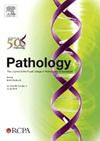基于rna的基因融合检测在诊断肿瘤科的实施:澳大利亚的观点。
IF 3
3区 医学
Q1 PATHOLOGY
引用次数: 0
摘要
准确检测致癌基因融合对于肿瘤亚群的组织学诊断是重要的。一些融合也是精确治疗的目标。我们描述了使用市售的Illumina TruSight RNA融合面板(TRFP)和Arriba融合检测算法检测融合的验证和早期诊断结果。回顾性验证表明,该分析对多种融合具有很高的准确性(94%的阳性预测一致性)。前瞻性诊断数据包括131个临床样本(102个间充质肿瘤,29个上皮肿瘤),其中80个是切除标本,51个是小标本,主要是核心活检。试验失败率为10.7%。我们在通过的样本中检测到64个(54.7%)具有临床可操作性的融合,其中12个(10.3%)改变了诊断或对诊断至关重要,14个(12.0%)具有潜在的治疗靶向性。大多数样本(89.7%)符合澳大利亚政府医疗福利计划部分报销的标准。除了描述基于rna的融合检测在癌症诊断中的效用外,希望本研究将为其他考虑引入此类检测的实验室提供实用建议。本文章由计算机程序翻译,如有差异,请以英文原文为准。
The implementation of an RNA-based gene fusion assay into a diagnostic oncology department: an Australian perspective
Accurate detection of oncogenic gene fusions is important for histological diagnosis of a subset of tumours. Some fusions are also the target of precision therapies. We describe our validation and early diagnostic results for the detection of fusions using the commercially available Illumina TruSight RNA Fusion Panel (TRFP) and the Arriba fusion detection algorithm. Retrospective validation showed that this assay demonstrated high accuracy (94% positive predictive agreement) for a wide variety of fusions. Prospective diagnostic data comprised a cohort of 131 clinical samples (102 mesenchymal tumours, 29 epithelial tumours), of which 80 were excisional specimens and 51 were small specimens, predominantly core biopsies. The test failure rate was 10.7%. We detected 64 (54.7%) clinically-actionable fusions in passed samples, including 12 (10.3%) that either changed or were critical for the diagnosis and 14 (12.0%) that were potentially therapeutically targetable. Most samples (89.7%) fulfilled criteria for partial reimbursement by the Australian Government Medical Benefits Scheme. In addition to describing the utility of an RNA-based fusion assay in cancer diagnostics, it is hoped that this study will provide practical advice for other laboratories considering introducing such a test.
求助全文
通过发布文献求助,成功后即可免费获取论文全文。
去求助
来源期刊

Pathology
医学-病理学
CiteScore
6.50
自引率
2.20%
发文量
459
审稿时长
54 days
期刊介绍:
Published by Elsevier from 2016
Pathology is the official journal of the Royal College of Pathologists of Australasia (RCPA). It is committed to publishing peer-reviewed, original articles related to the science of pathology in its broadest sense, including anatomical pathology, chemical pathology and biochemistry, cytopathology, experimental pathology, forensic pathology and morbid anatomy, genetics, haematology, immunology and immunopathology, microbiology and molecular pathology.
 求助内容:
求助内容: 应助结果提醒方式:
应助结果提醒方式:


